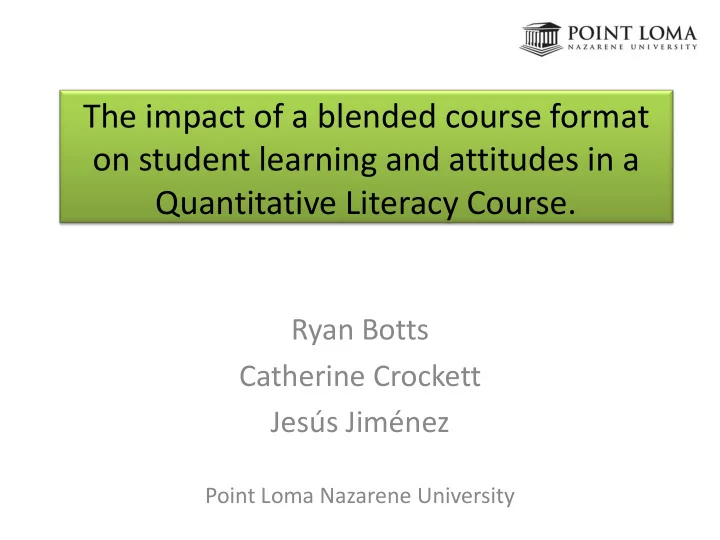

The impact of a blended course format on student learning and attitudes in a Quantitative Literacy Course. Ryan Botts Catherine Crockett Jesús Jiménez Point Loma Nazarene University
Outline o Background • Set up of the traditional and blended formats for a Problem Solving course o Data • Self reported time spent on tasks • Attitudes towards the course • Desire to learn in blended format • Traditional vs. Blended formats progress on learning outcomes o Future • Next steps
Traditional Format o 100% face-to-face class meetings o Collaborative work o Common syllabus, textbook, assignments and projects
Blended Format o 50% face-to-face class meetings, 50% online activities • One lab meeting per week (optional) o Common assignments for all blended sections o Same book, projects as traditional
Type of Student o Math G.E. requirement- non science majors. o Pre-requisites: • Elementary Algebra • Junior or Senior standing by completed units (at least 57 out of ~120)
Self-Reported Time on Task
Self-Reported Time on Task o Percent responding that they typically work in one long session as opposed to multiple short sessions: o Traditional format: 67% Blended format: 77% o -Not a significant difference o Attitudes about what helped: o Significant differences between blended vs. traditional in the helpfulness of reading, homework and in-class
Desire to Learn in the Blended Format Significant increase in their desire to take courses in this format.
Attitudes Toward the Course For statements 1, 2, 3 and 6, the differences are significant
Learning Outcomes (Spring 2014) None of these differences were significant due to sample size (n=20 blended, n=27 traditional)
Learning Outcomes (Spring and Fall 2014) n=60 blended n=37 traditional
Future: What is Next? o More data!!! • Compare actual time on task versus self-reported data • We need more longitudinal learning outcomes data o Modifications to Blended Format • Help students “feel” like they can solve problems
Thank You o Questions?
Attitudes Towards what was Helpful. Significant differences between blended vs. traditional in the helpfulness of reading, homework and in-class
Recommend
More recommend